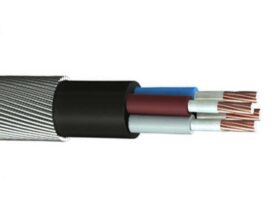Aerial power cables and electrical power cables are both used for transmitting electrical power, but they differ in terms of their installation methods and applications. Here are the key differences between the two:
- Installation Method:
- Aerial Power Cables: These cables are designed for overhead installations, where they are suspended from poles, towers, or other support structures. Aerial power cables are specifically engineered to withstand outdoor conditions, such as exposure to sunlight, wind, rain, and temperature variations. They are commonly used for power distribution in areas where underground installation is not feasible or cost-effective.
- Electrical Power Cables: These cables are designed for underground or indoor installations. They are typically buried in the ground or placed inside conduits, tunnels, or cable trays. Electrical power cables are insulated to provide electrical safety and protection against mechanical damage. They are commonly used in residential, commercial, and industrial applications, including building wiring, underground power distribution, and electrical equipment connections.
- Construction:
- Aerial Power Cables: Aerial power cables often have a bundled configuration, where multiple conductors are grouped together and covered with insulation. This design allows for easier installation and maintenance on overhead power lines. The conductors may be bare or covered with a layer of insulation, depending on the specific design and application requirements.
- Electrical Power Cables: Electrical power cables are typically constructed with multiple insulated conductors that are bundled together and surrounded by an outer protective sheath. The insulation materials used in electrical power cables provide electrical insulation and mechanical protection. The sheath offers additional protection against moisture, chemicals, and physical damage.
- Voltage Ratings:
- Aerial Power Cables: Aerial power cables are available in various voltage ratings, ranging from low voltage (LV) to medium voltage (MV) and high voltage (HV). They are used for power distribution networks at different voltage levels, depending on the specific application and local regulations.
- Electrical Power Cables: Electrical power cables are available in a wide range of voltage ratings, including low voltage (LV), medium voltage (MV), and high voltage (HV). They are used for a variety of applications, from low-voltage residential wiring to high-voltage transmission and distribution systems.
- Applications:
- Aerial Power Cables: Aerial power cables are primarily used for overhead power distribution networks in both rural and urban areas. They are commonly found in areas where it is not practical or cost-effective to install underground power lines, such as remote locations, rural regions, and areas with challenging terrain.
- Electrical Power Cables: Electrical power cables are used in a wide range of applications, including residential, commercial, and industrial settings. They are suitable for underground installations, building wiring, power transmission and distribution, connection of electrical equipment, and various other electrical systems.
In summary, the main difference between aerial power cables and electrical power cables lies in their installation methods and intended applications. Aerial power cables are designed for overhead installations in outdoor environments, while electrical power cables are intended for underground or indoor installations.











Leave a Reply